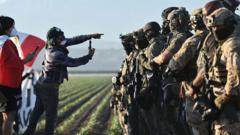In the once-thriving neighborhoods of St. Louis, Thomasina Clarke reflects on the history of her community through the schools that have gradually disappeared over the years. Having endured a damaging tornado this spring, the fear now looms of losing a vital high school, notable for its alumni including legends like Tina Turner and Chuck Berry.
As St. Louis Public Schools contemplates which schools to keep amid shrinking budgets and a decline in student population, the situation mirrors trends seen nationwide. A district report indicates the school system is overextended with more than twice the number of schools needed.
Closure decisions are painful, not just for financial reasons but because they often lead to negative outcomes for children. Reports suggest that students from closed schools face increased challenges, a concern underscored by other cities like Philadelphia and Chicago, where school closures have sparked protests and community dissent.
A report from the Thomas B. Fordham Institute revealed that from 2019 to 2023, a significant number of public schools saw their enrollment drop by over 20%. Factors such as declining birth rates, a move to private schools, and demographic shifts all contribute to projected declines in public school enrollments.
In Chicago, the aftermath of the largest school closure in U.S. history in 2013 led to increased bullying and academic struggles for students as they adjusted to new environments. Despite pressures and activism from teachers’ unions, the moratorium on closures hasn't resolved the underlying issue of empty classrooms.
In St. Louis, the number of students enrolled in public schools has dwindled dramatically, reflecting a broader trend of families relocating to suburban areas. This has prompted discussions over which schools might face permanent closure after being temporarily shuttered due to tornado damage.
As discussions unfold, voices in the community are advocating against closure, emphasizing the vital role these schools play in providing hope and stability to local families. The community's push to safeguard institutions like Sumner, which has seen efforts to enhance its curriculum and uplift student enrollment, epitomizes the fight against educational disenfranchisement.
Among the students, Dakota Scott's narrative shines as a testament to the school's impact. After transferring to Sumner and experiencing a transformation as a student, she embodies the potential that these schools hold for fostering resilience and ambition in students.
For Clarke and others, the battle to preserve their schools isn't just about education; it's about maintaining the legacy and spirit of a community that yearns for revival amidst adversity.




















